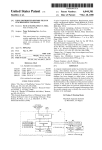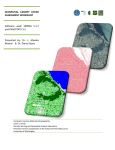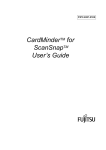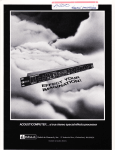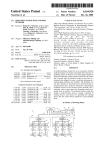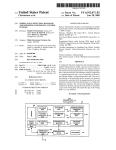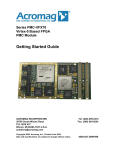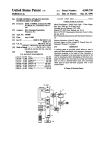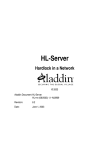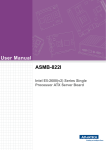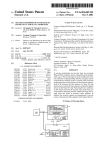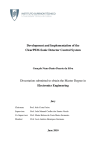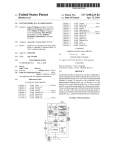Download Method of and apparatus for protecting and upgrading software
Transcript
US006023763A United States Patent [19] [11] Patent Number: 6,023,763 Grumstrup et al. [45] Date of Patent: Feb. 8, 2000 [54] METHOD OF AND APPARATUS FOR PROTECTING AND UPGRADING SOFTWARE USING A REMOVABLE OTHER PUBLICATIONS Crypkey Home Page, 2 pp. (Jul. 1997). Crypkey Software Licensing System User Manual, pp. II, HARDLOCK [75] 55—62 (Sep. 1995). Aladdin Hardlock Home Page, 2 pp. (Jul. 1997). Inventors: Bruce F. Grumstrup; Patrick 0. Ryan, both of Marshalltown, Iowa Primary Examiner—Robert W. Beausoliel, Jr. [73] Assignee: Fisher Controls International, Inc., Clayton, Mich. Assistant Examiner—Brian H. Shaw [21] Appl. No.1 08/842,050 [22] Filed: Apr. 23, 1997 [57] [51] [52] [58] 380/4 References Cited U.S. PATENT DOCUMENTS 5,008,814 4/1991 5,018,096 5/1991 Aoyama 5,138,712 5,144,664 8/1992 9/1992 Murray & Borun ABSTRACT A software protection method and apparatus uses a remov Int. Cl.7 .................................................... .. G06F 12/14 US. Cl. ............................................... .. 713/200; 380/4 Field Of Search ............................... .. 713/200; 380/3, [56] Attorney, Agent, or Firm—Marshall, O’Toole, Gerstein, Mathur .................................. .. 364/200 364/900 Corbin .................................. .. 395/700 Esserman et al. ...................... .. 380/20 5,155,847 10/1992 Kirouac et al. 395/600 5,359,730 10/1994 Marron ........ .. 395/650 5,375,206 12/1994 Hunter et al. . 395/200 5,473,692 12/1995 Davis ...................................... .. 380/25 able hardlock to prevent the unauthorized installation and/or use of a licensed software program. The removable hardlock, when supplied to a user, stores an access variable indicating the number of licenses available for the software program. During installation of the software program on a computer, the removable hardlock is inserted into an exter nal port of the computer and the access variable is read to determine if any licenses for the software program are still available. If so, the software program is installed on the computer in a manner that allows the software program to be run on the computer when the removable hardlock is removed from the external port of the computer. The access variable on the removable hardlock is then decremented to indicate that one of the previously available licenses has now been used. However, when the access variable on the removable hardlock indicates that no further licenses are 5,533,125 7/1996 Bensimon et a1. ........................ .. 380/4 available, the software program is installed on the computer 5,553,143 9/1996 in a manner that prevents the software program from being implemented on the computer when the removable hardlock Ross et a1. ........ . . . .. 5,564,038 10/1996 GrantZ et al. 5,564,108 10/1996 Hunsaker et al. 5,577,244 11/1996 Killebrew et al. 5,579,479 5,826,011 11/1996 10/1998 380/25 395/491 395/800 395/703 is removed from the external port of the computer. Plum ............... .. 395/188.01 Chou et a1. ........................... .. 395/186 21 Claims, 3 Drawing Sheets 16 ID#: 12345 COMPANY: SITE‘ 64 u - » FULLCNT: 2 FEAT: MUX TAGCNT: 200 UPGCNT: o OLDFEAT ' OLDTAGCNT: 0 |D#: 12345 COMPANY: ACME SlTE: MTOWN FEAT: MUX TAGCNT' 200 16 66 RUN FLAG: NO HL ID#: 12345 COMPANY: ACME SITE: MTOWN FULLCNT: 1 FEAT, MUX TAGCNT. 200 UPGCNT: 0 OLDFEAT: - OLDTAGCNT: O ID#. 12345 COMPANY: ACME SITE: MTOWN FEAT: MUX TAGCNTI 200 RUN FLAG: NEED HL U.S. Patent Feb. 8,2000 Sheet 1 of3 6,023,763 FIG. 1 FIG. 2 Mm RCA M M m,-I 2//R _|1$ |L_ \ _ MN 6N|_. m sDR on u AuECCRKEE Rw... SN TL 2_ /_ / _ _ __ _ _ %_ _ m _ _ 0 _ __ _ , |Fl F \J _ O _ _ _ M 2 U.S. Patent Feb. 8,2000 Sheet 2 of3 6,023,763 1? ID#: 12345 COMPANY: SITE: 64 H - - FULLCNT: 2 FEAT: MUX TAGCNT: 200 UPGCNT: 0 ID#: 12345 OLDFEAT: - COMPANY: ACME OLDTAGCNT: 0 SITE: MTOWN FEAT: MUX TAGCNT: 20o 16\ RUN FLAG: NO HL 0 ID#: 12345 66 u COMPANY: ACME SITE: MTOWN FULLCNT: 1 FEAT: MUX TAGCNT: 200 UPGCNT: 0 ID#: 12345 OLDFEAT: - COMPANY: ACME OLDTAGCNT: 0 SITE: MTOWN FEAT: MUX TAGCNT: 20o RUN FLAG: NEED HL FIG. 3 2 U.S. Patent Feb. 8,2000 Sheet 3 0f 3 6,023,763 16A |D#: 12346 COMPANY: SITE: 70 - - FULLCNT: O FEAT: MUX, VSIG TAGCNTI 400 UPGCNT: 1 OLDFEAT: MUX OLDTAGCNTI 200 16A |D#: 12346 COMPANY: ACME SITE: MTOWN FEAT: MUX, VSIG |D#: 12346 COMPANY: ACME TAGCNT: 400 RUN FLAG: NEED HL SITE: MTOWN FULLCNT: O 72 FEAT: MUX,VSIG TAGCNT: 400 UPGCNT: 1 OLDFEATI MUX OLDTAGCNTI 200 74 16A COMPANY: ACME SITE‘. MTOWN \ FEAT: MUX,VSIG |D#: 12346 TAGCNTZ 400 RUN NO HL COMPANY: ACME SITE: MTOWN FULLCNTI 1 FEAT: MUX,VS|G TAGCNTI 400 UPGCNTI O OLDFEAT: MUX OLDTAGCNT: 200 FIG. 4 0 6,023,763 1 2 METHOD OF AND APPARATUS FOR PROTECTING AND UPGRADING SOFTWARE USING A REMOVABLE HARDLOCK unauthoriZed installation and use of a licensed softWare program. The removable hardlock may have an access variable stored thereon indicating the number of licenses available With the hardlock. During installation of the soft Ware program on a particular computer, the removable TECHNICAL FIELD hardlock is inserted into an external port of the computer and the softWare is provided to the computer in any convenient The present invention relates generally to software pro tection methods and devices and, more particularly, to a method of and an apparatus for preventing the unauthorized use of licensed softWare using a removable hardlock. 10 BACKGROUND ART It is knoWn to prevent the unauthoriZed copying or use of softWare programs supplied by a softWare licensor to a licensee using either a hardlock or a softlock protection manner. An installer associated With the softWare or the computer then reads the access variable on the hardlock to determine if any licenses for the softWare program are available. If desired, the access variable may represent the number of unused licenses that have been purchased for the softWare program. If one or more unused licenses are available, the installer installs the softWare program on the computer and decrements the access variable to indicate that method. A hardlock protection method requires that a hard 15 one of the previously available licenses has noW been used. lock be inserted into and remain in an external port of a The softWare may be installed on the computer in a manner computer or a processor for the licensed softWare program that ties the softWare to the hard drive serial number of the to run on that computer. The hardlock, Which is a physical computer to prevent the installed softWare from being cop device typically having a microprocessor and/or a memory unit therein, may store, for example, an access code required ied to and run on a different computer. After installation is complete, the hardlock can be removed from the external by the licensed softWare to run a on the computer. Thus, port of the computer Without effecting the operation of the although the licensed softWare program may be loaded onto softWare program stored on the computer. The removable any computer, the softWare program Will only run on a hardlock can then be used to install the softWare program on computer that has the hardlock supplied With that softWare other computers until the access variable indicates that all of program inserted into an external port thereof. While hardlocks operate to prevent unauthoriZed imple 25 mentation of a softWare program, a separate hardlock must be provided for each licensed copy of the softWare program. contact the softWare vendor to obtain access codes, etc. and does not require that a hardlock be inserted into an external Furthermore, a hardlock must be left in an external port of each computer on Which the licensed softWare program is port of a computer When the softWare program is actually being implemented or being run on the computer. installed While the licensed softWare program is actually running. This requirement can become problematic if mul According to another aspect of the present invention, the tiple hardlock-protected softWare programs are to be run on removable hardlock can be left in the external port of a any particular computer. Furthermore, if the hardlock is accidentally damaged or lost, the properly licensed softWare program cannot be implemented on the computer, Which is inconvenient for the licensee. A softlock protection method typically uses a protection code stored in softWare supplied With a purchased softWare program to limit the use or implementation of the softWare the purchased licenses have been used. As Will be understood, the removable hardlock of the present invention does not require the softWare licensee to computer and used to implement a single backup or unli 35 censed copy of the softWare program at any time. This function is desirable When, for example, a licensed copy of the softWare program installed on a computer has been accidentally erased, damaged, or destroyed. According to a still further aspect of the present invention, the removable hardlock of the present invention may be used program to a particular machine, such as to one having a to install and run an upgrade program on a computer Which speci?c identi?cation number. Generally, to install a licensed softWare program protected With a softWare lock, i.e., a softlock, the purchased softWare runs an install program that reads the serial number of the hard drive of the has a base program already installed thereon. In this case, the removable hardlock may include one or more variables that indicate the features of, or that otherWise identify, the base program Which must be already installed on the computer for the upgrade program to be installed thereon. An installer associated With the computer determines the features of the base program installed on the computer and compares these computer on Which the licensed softWare program is to be 45 loaded and generates a hard drive code therefrom. A user then contacts the softWare licensor With the hard drive code features With the set of features stored on the hardlock. If the to obtain an access code, Which the user enters into the tWo sets of features match, the installer installs the upgrade computer. The install program then links the access code of program on the computer. OtherWise, the installer recog the softWare program to the hard drive serial number and niZes that the upgrade program is not an upgrade to the base program currently installed on the computer and prevents installation of the upgrade program. installs the softWare program on the computer. Thereafter, the softlock only alloWs the access coded softWare program to be run on the computer having the hard drive With the previously determined hard drive serial number. Using a softlock protection method, a user cannot initially install a licensed softWare program Without contacting the softWare vendor and, furthermore, cannot de-install a licensed softWare program from one computer and install that program on a different computer Without contacting the BRIEF DESCRIPTION OF THE DRAWINGS 55 FIG. 1 is a perspective vieW of a computer capable of installing and running licensed softWare using a removable hardlock according to the present invention; FIG. 2 is a block diagram of the computer and the removable hardlock of FIG. 1; softWare vendor. HoWever, contacting the softWare vendor FIG. 3 is a flow chart illustrating the installation of a base program on a computer using the removable hardlock of the to obtain access codes and to re-install licensed softWare programs on different computers is inconvenient, time present invention; and consuming, and tedious for the licensee. SUMMARY OF THE INVENTION The softWare protection method and apparatus of the present invention uses a removable hardlock to prevent the 65 FIG. 4 is a flow chart illustrating the installation of an upgrade program on a computer having an installed base program using the removable hardlock of the present inven tion. 6,023,763 3 4 DETAILED DESCRIPTION remains. The hardlock 16 can then be removed from the computer 10 and the installed softWare can be run thereon. If, after this installation, the access variable on the hard The software protection method and apparatus of the present invention can be used to assure that, When a softWare licensor or vendor sends out a softWare program, the soft Ware program can be installed and run on only the number lock 16 indicates that one or more licenses are still available, the hardlock 16 can then be inserted into one or more further computers and used to install the softWare program on those computers. In this manner, a single removable hardlock of computers for Which a license has been purchased. Furthermore, Where any of a number of serial softWare upgrades of a particular softWare program are available, the device can be used to install a softWare program on numer ous machines or computers, With the number of installations softWare protection method and system of the present inven tion can be used to assure that a neW softWare upgrade is only installed and run on a system having base softWare already upgraded to the level immediately beloW the level of the neW softWare upgrade. Thus, for example, the softWare protection method and system of the present invention can be used to distribute softWare capable of having upgrades A 15 to D in a manner that assures that the upgrade D is only installed on a system having upgrade C already installed thereon. Referring noW to FIG. 1, a computer 10 Which may being set by the softWare licensor as the number of licenses purchased for the softWare program. Referring noW to FIG. 2, the components Within the computer 10 that install and/or de-install a softWare program 20 on the computer 10 according to the present invention are illustrated. With the hardlock 16 inserted into the external port 14 of the computer 10, an installer 22 operates to install the softWare program 20 on the computer 10. The installer 22, Which may perform any functions associated With a standard softWare installer routine and Which may be imple mented by softWare stored in the computer 10 and/or pro comprise any machine, processor, microprocessor, hard vided With the disk 12 (FIG. 1), ?rst loads the softWare Wired machine, or any other type of computer capable of program 20 from the disk 12 into a memory 23 of the computer 10. Thereafter, a communication program Within the installer 22 reads the value of an access variable stored Within the memory of the hardlock 16 to determine if the implementing or running a softWare program, such as a base softWare program or an upgrade softWare program, is illus trated. If desired, the computer 10 may implement process control softWare and, as such, may be coupled to process control devices via standard connections. The computer 10 25 hardlock 16 has one or more unused softWare licenses associated thereWith. If the access variable on the hardlock 16 indicates that one or more licenses for the softWare may alternatively be used to run any other type of softWare and, as such, may be connected to any other hardWare program are still available, a softWare conditioner Within the installer 22 sets a run ?ag 24 associated With the softWare program 20 to a ?rst state indicating that the softWare program 20 can be implemented or run by the computer 10 necessary for implementation of that softWare. Likewise, if the softWare can be implemented solely by the computer 10, the computer 10 may be a stand-alone unit. As is typically the case, the computer 10 includes an external disk drive 11 adapted to accept a disk 12 having the licensed softWare program or upgrade program stored thereon. Alternatively, the licensed softWare program or upgrade program may be provided to the computer 10 in any other desired manner, including, for example, via a com 35 after the hardlock 16 is removed from the external port 14. If, hoWever, the access variable on the hardlock 16 indicates that no further softWare licenses are available, the softWare conditioner of the installer 22 sets the run ?ag 24 to a second state indicating that the softWare program 20 cannot be implemented or run on the computer 10 Without the hardlock munication channel such as the internet, a modem 16 physically inserted into the external port 14 thereof. connection, etc. As illustrated in FIG. 1, the computer 10 When the installer 22 sets the run ?ag 24 to the ?rst state, the communication program of the installer 22 changes the also includes a set of standard external ports 14 Which may be, for example, printer ports, serial ports, etc. Aremovable hardlock 16 provided With, for example, the disk 12, is con?gured to be inserted into one of the external ports 14 of the computer 10. The removable hardlock 16 may comprise a microprocessor and/or any hardWired logic device having a memory therein for storing an indication of 45 the number of licenses that have been purchased or that are available for the softWare program stored on the disk 12. The hardlock 16 also includes connections for electrically con a value or a state Which indicates that no further licenses are available. Preferably, the installer 22 installs the softWare program necting the hardlock 16 to the external port 14 of the on the computer 10 in a manner that ties the softWare program to some unique identi?er associated With the com computer 10 in any knoWn or desired manner. Generally, to install the softWare program stored on the disk 12 on the computer 10, the disk 12 is inserted into the disk drive 11 While the removable hardlock 16 is inserted into, for example, the printer port 14. When an access variable stored Within a memory of the hardlock 16 indicates puter 10, such as the hard drive serial number of the computer 10. This function, Which may be implemented 55 that an unused license for the softWare program on the disk 12 is available, an installer associated With the computer 10 and/or provided With the disk 12 installs the softWare program on the computer 10 in a manner that alloWs the softWare program to be run by the computer 10 When the hardlock 16 is removed from the external port 14 of the computer 10. After installing the softWare program on the computer 10 in this manner, the installer changes the access variable on the hardlock 16 to indicate that one less unused license for the softWare program stored on the disk 12 access variable stored Within the memory of the hardlock 16 to another value indicating that one of the unused softWare licenses associated thereWith has noW been used. If, before installation, the access variable stored Within the memory of the hardlock 16 indicates that only one unused license remains, then the installer 22 changes the access variable to 65 using a standard softlock routine With the exception that the access code is provided by the hardlock 16 instead of a softWare provider, prevents copying and use of the installed softWare on a different computer or machine. Also, during the installation process, the communication program of the installer 22 can accept information from a user relating to, for example, identi?cation of the computer 10 or the location of the computer 10, and may store such information Within the memory of the hardlock 16. If such information has already been stored on the hardlock 16 in a previous installation process, the communication program of the installer 22 may read such information from the hardlock 16 and store it in a memory associated With the program 20 6,023,763 5 6 Which, thereafter, can be used to prevent the program 20 from being copied and implemented on a different computer, disk 12, operates to alloW a user to de-install the softWare program 20 from the computer 10 When a proper hardlock 16 is inserted into the external port 14. Such a de-installer at a different location, etc. identity of the softWare program 20 being installed on the 28, When run by the operator, removes the program 20 from the memory 23 of the computer 10 and/or changes the run ?ag 24 to the second state indicating that the softWare computer 10. During installation, the communication pro program 20 cannot be run Without the hardlock 16 inserted gram of the installer 22 can read the values of these variables from the hardlock 16 and store indications of the values of these variables in a memory associated With the licensed softWare program 20. Such an ID number or list of features may be used to assure that an inserted hardlock is the proper 10 into the external port 14. Thereafter, a communication program Within the de-installer 28 changes the access vari able stored in the memory of the hardlock 16 to indicate that 15 that variable. After this operation, the hardlock 16 can be removed from the computer 10, inserted into at least one other computer and be used to install the softWare program 20 on the other computer. In this manner, the softWare Further, if desired, the hardlock 16 may store an ID number and/or a set of variables that indicate the features or hardlock for the softWare program being installed and/or to control the features purchased by the softWare user. During installation of an upgrade program, i.e., a softWare program having an expanded set of features designed to upgrade a base program having a subset of the expanded set of features, a comparator Within the installer 22 determines if the set of features associated With a program already installed on the computer 10 (stored in the computer memory) has all of the features of the base program for a further license is available by, for example, incrementing licenses initially provided With the hardlock 16 are fully transportable betWeen computers. It is also desirable to have the hardlock 16 operate to alloW the use of a single backup copy of the licensed softWare program 20, i.e., to alloW a single backup copy of the licensed softWare program 20 to be run on any given Which the upgrade program is designed (stored in the hardlock memory). In this manner, the installer 22 veri?es that the upgrade program is being installed on a computer that has the licensed base program for Which the upgrade program Was designed already installed thereon. For example, in a system capable of running any one computer using the hardlock 16. To assure this function, a hardlock interface 30 associated With the softWare program 20 includes a detector that detects Whenever a proper 25 version of a softWare program having a base version A and a proper hardlock 16 is installed in the external port 14, the detector of the hardlock interface 30 generates a signal that informs the softWare program 20 of the existence of the installed hardlock 16. At that time, the softWare program 20 a set of upgrade versions B, C, and D, the hardlock associ ated With the upgrade version D may store a list of the features or other identifying indication(s) associated With the previous version C, i.e., the features required to be associ ated With the program actually installed on the computer is enabled to be run by the computer 10 no matter What the setting of the run ?ag 24 happens to be. Thus, even if the before the upgrade version D can be installed on that computer. During installation of the upgrade program, the hardlock 16 (e.g., one having the same features as the features of the installed softWare program 20) is physically inserted into the external port 14 of the computer 10. When access variable on the hardlock 16 indicates that no unused 35 licenses are available for the softWare program 20, the communication program of installer 22 reads the set of softWare program 20 can be installed and run on any features associated With the softWare program actually installed on the computer. The comparator of the installer 22 then compares these read features or other indication(s) With the list of features or indication(s) stored in the hardlock 16 as being necessary for the upgrade program to be installed computer as long as the hardlock 16 is actually physically inserted into the external port 14 of that computer. In this manner, the hardlock 16 operates to alloW the installation and/or implementation of one copy (a backup copy) of the softWare program at any time. The backup copy can be moved from one computer to another by simply moving the hardlock 16 to another computer and leaving the hardlock 16 inserted in the external port thereof While running the on the computer. If the sets of features or indication(s) match, and the access variable of the hardlock 16 indicates that one or more unused licenses are available for the upgrade program, the installer 22 installs the upgrade pro 45 softWare program 20. Of course if this backup feature is not gram on the computer 10. HoWever, if the tWo sets of features or indication(s) do not match, Which occurs When, desired, the installer 22 may be designed to condition the softWare program 20 by prohibiting the installation of the for example, the installed program only has features asso ciated With version A and/or version B, then the installer 22 recogniZes that the user is trying to install the upgrade version D Without having purchased a license for or properly installed upgrade version C and prevents installation of the softWare program 20 Whenever the access variable Within the hardlock 16 indicates that no further unused licenses are upgrade version D on the computer 10. In such a case, the installer 22 may inform the user that installation is not alloWed because upgrade version C has not been installed on available. FIG. 3 illustrates the state of certain variables Within the hardlock 16 both before and after using the hardlock 16 to install the base softWare program 20 on computers 60 and 62. Before any installation, the hardlock 16 (as indicated at 55 the block 64) stores an ID number (typically provided by the the computer 10. softWare provider or the licensor), a company and site Of course, the list of features or other indication(s) may be stored in any desired format including as text or, preferably, as a bit ?eld, Wherein each bit Within the bit ?eld identi?es a different feature of the licensed softWare pro gram or the upgrade program. If desired, the installer 22 may also display the features or other information stored in the hardlock 16 on a display screen and/or may update the variable (typically left blank by the softWare provider) and display screen to indicate the speci?c operation being per formed during the installation process. A de-installer 28, Which also may be implemented by softWare stored on the computer 10 and/or provided With the a FULLCNT (full count) variable that indicates the number of licenses currently associated With the hardlock 16. The FULLCNT variable may be set to a number that is one greater than the number of licenses purchased by the user for the base softWare program 20. The hardlock 16 also includes a FEAT (features) variable that indicates the features of the softWare program 20 associated With the hardlock 16 and a 65 TAGCNT (tag count) variable that indicates the number of tags associated With the base softWare program 20. These tags might indicate, for example, the maximum number of 6,023,763 8 7 If desired, during installation of the base softWare pro devices to be controlled by a licensed process control software program. If desired, the hardlock 16 may also store gram 20 on any computer or machine other than the ?rst computer, an installer may check to see if the company, site, an UPGCNT (upgrade count) variable that indicates the and/or other information provided by a user match the values of those variables stored Within the hardlock 16 and, number of licenses available for an upgrade program asso ciated With the hardlock 16. Typically, if the FULLCNT variable is set to any number greater than Zero, then the UPGCNT variable is set to Zero and vice-versa. The hard lock 16 may also store an OLDFEAT (old features) variable in the event that a match does not occur, may prevent installation of the softWare program 20. This operation prevents the hardlock 16 from being transported to comput that is used When the softWare being installed is an upgrade ers at other companies or sites for Which softWare licenses have not been obtained, even When the hardlock 16 indicates that unused licenses are still available for the initial com to a softWare program already installed on a computer. The OLDFEAT variable indicates the features or identity of the installed program for Which the upgrade program is pany and/or site. Likewise, as indicated above, during any designed. An OLDTAGCNT (old tag count) variable may be used to indicate the tag count of the softWare program already installed on a computer on Which an upgrade pro gram is to be installed. Of course the FEAT, TAGCNT, OLDFEAT, and OLDTAGCNT variables are set by the softWare vendor before the hardlock 16 is shipped to the softWare licensee. If, as in FIG. 3, the UPGCNT variable is set to Zero, the OLDFEAT variable may be left blank. To install the base softWare program 20 on the computer 60, the hardlock 16 (block 64) is inserted into an external port of the computer 60 and the base softWare program 20 is loaded onto the hard drive thereof. During installation, an installer of the computer 60 checks for the insertion of a proper hardlock using, for example, the hardlock interface 30 (FIG. 2). The installer then determines if the FULLCNT variable is greater than one and, if so, installs the base softWare program 20 on the computer 60 setting the run ?ag 15 can only be run on that computer. FIG. 4 illustrates the state of the variables Within a removable hardlock 16a both before and after the removable hardlock 16a is used to install an upgrade program on the computers 60 and 62, each having a base softWare program 20 installed thereon in the manner illustrated in FIG. 3. In the example illustrated in FIG. 4, the UPGCNT variable of the hardlock 16a (block 70) is initially set to one, indicating 25 that only one license for the upgrade program remains on the hardlock 16a. HoWever, it should be understood that the UPGCNT variable can be set to any other positive number to indicate that more licenses for the upgrade program are 24 of the base softWare program 20 to a state illustrated in FIG. 3 as “NO HL,” indicating that the base softWare program 20 can be run Without the hardlock 16 inserted in the computer 60. During the installation process, the installer stores the ID number of the hardlock 16 in the computer 60. The installer may request the user to enter the company and site associ installation of the softWare program 20 on any computer, the softWare program 20 is tied to a unique identi?er associated With that computer to assure that the softWare program 20 35 available. During installation of the upgrade program on the com puter 62, Which has the base program 20 stored With a run ?ag set to “NEED HL,” the installer of the computer 62 ?rst determines if the OLDFEAT and OLDTAGCNT variables of the hardlock 16a match the FEAT and TAGCNT variables associated With the base softWare program 20. If so, the installer identi?es that the base softWare program installed ated With the computer 16 and may then store this informa on the computer 62 is a proper base program to Which the tion in both the computer 60 and the hardlock 16 (block 66) upgrade program can be applied. The installer then installs the upgrade program on the computer 62 and stores the company and site variables that have been stored in the computer 62 for the base softWare program 20 on the as the company and site variables. The installer also copies the FEAT and TAGCNT variables from the hardlock 16 and stores the values of these variables in a memory of the computer 60 to indicate the features of the base softWare program 20 actually installed on the computer 60. After a successful installation, the installer of the com puter 60 decrements the FULLCNT variable on the hardlock 16 by one (block 66) to indicate that one of the previously hardlock 16a (block 72). During installation of the upgrade program, the ID, FEAT, and TAGCNT variables Within the computer 62 are set equal to the ID, FEAT, and TAGCNT variables on the hardlock 16a, respectively, to identify the 45 available licenses has been used. The hardlock 16 can then be removed and used to install the base softWare program 20 in other computers until the FULLCNT variable of the hardlock 16 reaches one, as illustrated at the block 66. When the FULLCNT variable on the hardlock 16 is equal to one, indicating that no further unused softWare licenses installer associated With the computer 62 leaves the run ?ag of the installed upgrade program set to “NEED HL” because the base softWare program 20 originally installed on the computer 62 had a run ?ag set equal to “NEED HL” indicating that a hardlock must be inserted into the computer 62 to run the base softWare program 20. Thus, the upgrade program installed on computer 62 Will still require the hardlock 16a to be inserted into an external port thereof to are available (block 66), and the hardlock 16 is inserted into, for example, the computer 62, an installer of the computer 62 Will still install the base softWare program 20 on, and Will copy the company, site, FEAT and TAGCNT variables to the computer 62, but Will set the run ?ag to a second state illustrated in FIG. 3 as “NEED HL,” indicating that the base softWare program Will only run on the computer 62 When the hardlock 16 is physically inserted into the proper external port thereof. Because the installation of the base softWare 55 longer Work to alloW the use of a backup copy of the program noW installed on the computer 62 because the ID, licenses purchased for that softWare but, instead, operates only to install a backup copy of that softWare on the computer 62 to be run When the hardlock 16 is installed in computer 62 does not change the FULLCNT variable or any other variable of the hardlock 16. run the upgrade program and, essentially, can still only operate as a backup copy of the upgrade program. Furthermore, the original hardlock 16 (FIG. 3) Will no program 20 on the computer 62 does not use any of the the external port of the computer 62, the installer of the neW program stored on the computer 62. HoWever, the 65 FEAT, and TAGCNT variables of the installed upgrade program do not match those of the original hardlock 16. Instead, the hardlock 16a must be inserted into the external port of the computer 62 to run the backup copy of the upgrade program noW installed on the computer 62. Because the run ?ag of the upgrade program on the computer 62 is set equal to “NEED HL,” the installer associated With the computer 62 does not decrement the UPGCNT variable on the hardlock 16a during installation (block 72). 6,023,763 9 10 Next, When the hardlock 16a (block 72) is inserted into hardlock, or at any other desired location. Furthermore, the external port of the computer 60, the installer on the computer 60 compares the FEAT and TAGCNT variables of the base software program 20 installed thereon With the these components could additionally or alternatively be implemented in ?rmWare or hardWare supplied With, for example, the licensed softWare or the removable hardlock. While the present invention has been described With reference to speci?c examples, Which are intended to be OLDFEAT and OLDTAGCNT variables on the hardlock 16a. If the installer ?nds that these variables match, the installer installs the upgrade program on the computer 60. Of course, if these sets of variables do not match, the installer of the computer 60 recogniZes that it is not proper to install the upgrade program associated With the hardlock 16a With the base program currently installed on the computer 60 and prevents such installation. When, as is the case With the computer 60 of FIG. 4, the run ?ag of the base softWare program 20 stored on the computer 60 is set to “NO HL,” indicating that the base illustrative only, and not to be limiting of the invention, it Will be apparent to those of ordinary skill in the art that changes, additions and/or deletions may be made to the disclosed embodiments Without departing from the spirit and scope of the invention. We claim: 1. A softWare protection system adapted to enable imple mentation of a softWare program on a computer having an external port, the softWare protection system comprising: 15 softWare program 20 can be run Without the hardlock 16 including an access variable set to one of a plurality of UPGCNT variable on the hardlock 16a is greater than Zero, values; and indicating that a license for the upgrade program is still available, the installer of the computer 60 sets the run ?ag of the neWly installed upgrade program to “NO HL” and an installer that installs the softWare program on the computer When the removable hardlock is inserted into the external port of the computer, including; decrements the UPGCNT variable on the hardlock 16a (block 74) to indicate that one of the licenses thereon has been used. Thereafter, the hardlock 16a may be removed from the external port of the computer 60 and the upgrade program can be run thereby. Also, the hardlock 16a may be used to install the upgrade program on other computers until the UPGCNT variable reaches Zero (e.g., block 74), at Which time the FULLCNT variable may be set equal to one (block means for reading the access variable, and means for conditioning the softWare program to prevent the softWare program from being implemented on 25 the computer When the access variable is set to a ?rst value and the removable hardlock is removed from the external port and to alloW the softWare program to be implemented on the computer When the access variable is set to a second value and the removable 74) to alloW the hardlock 16a to be used to run a backup hardlock is removed from the external port. 2. The softWare protection system of claim 1, further including a hardlock interface including means for detecting copy of the upgrade program. As indicated above, a de-installer may operate to remove a softWare program and/or an upgrade program from any computer When a hardlock having the same, for example, ID, FEAT, and/or TAGCNT variables as the installed soft a removable hardlock adapted to be inserted into the external port of the computer, said removable hardlock installed in an external port of the computer 60, and the When the removable hardlock is inserted into the external port and means for enabling the softWare program to be 35 Ware program is inserted into an external port of the com implemented by the computer When the detecting means detects that the removable hardlock is inserted into the external port. 3. The softWare protection system of claim 1, Wherein the puter. During this process, the de-installer may increment the FULLCNT or UPGCNT variable Within the hardlock 16 or 16a (When the de-installed program has a run ?ag set to the state indicating that the program can be run Without the installer includes means for changing the value of the access variable on the removable hardlock When the conditioning means conditions the softWare program to alloW the soft hardlock inserted into an external port of the computer) to thereby indicate that the hardlock 16 or 16a noW has one additional unused license associated thereWith. While the system and method for using a removable hardlock described herein includes a FULLCNT and/or an 45 UPGCNT variable that indicates the number of unused licenses available With a hardlock, other variables and values Ware program to be implemented by the computer When the removable hardlock is removed from the external port. 4. The softWare protection system of claim 3, Wherein the changing means changes the value of the access variable from the second value to the ?rst value. 5. The softWare protection system of claim 3, Wherein the changing means decrements the access variable value. for these variables could be used or stored as the access 6. The softWare protection system of claim 1, Wherein, at variable and still fall Within the scope of this invention, as any particular time, the value of the access variable indicates the number of further computers on Which the softWare program can be installed and then implemented Without the removable hardlock inserted into an external port of the long as the access variable can be changed from one state to another state to indicate that there are no more unused licenses available With the hardlock. Moreover, other further computers. 7. The softWare protection system of claim 1, Wherein the mechanisms besides a run ?ag could be used to prevent or enable implementation of the softWare program 20 When the removable hardlock 16 or 16a is removed from the external port 14 of the computers 10, 60, and 62. Furthermore, if desired, the removable hardlocks 16 and/ or 16a can store other information pertaining to the softWare 55 softWare program is an upgrade program and Wherein the value of the access variable indicates the number of further computers on Which the upgrade program can be installed and then implemented Without the hardlock inserted into an With the above-described information to install or de-install softWare in any desired manner. Still further, While the external port of the further computers. 8. The softWare protection system of claim 1, Wherein the removable hardlock is adapted to be inserted into the exter nal port of the computer When the computer has an installed program installed thereon, installer, de-installer, and hardlock interface have been gen erally described herein as separate softWare programs stored in a computer and/or supplied With the licensed softWare, these programs could, instead or additionally, be part of the Wherein the softWare program is an upgrade program, Wherein the removable hardlock includes a further vari able that stores a ?rst set of parameters identifying a base program With Which the upgrade program can be program, the computers, the user, the softWare licensor, etc. and this additional information can be used in connection licensed softWare and/or could be stored on the removable installed, and 6,023,763 11 12 wherein the installer includes means for comparing a Wherein the computer includes an installed program second set of parameters identifying the installed pro gram With the ?rst set of parameters to determine if the Wherein the memory stores a second variable indicating a ?rst and second sets of parameters match and means for base program With Which the upgrade program can be installed thereon, preventing installation of the upgrade program on the computer When the ?rst and second set of parameters installed, and Wherein the installation program includes means for com do not match. paring an installed program variable indicating the 9. The softWare protection system of claim 8, Wherein the removable hardlock includes another variable relating to the upgrade program and Wherein the installer includes means for storing values associated With the another variable in the computer When the upgrade program is installed on the installed program With the second variable and means 10 17. The softWare protection system of claim 16, Wherein computer. 10. The softWare protection system of claim 1, Wherein the removable hardlock includes a set of further variables 15 relating to the identi?cation of the computer and the installer includes means for obtaining values relating to the identi ?cation of the computer and means for storing the obtained variables. the installation programs includes means for associating implementation of the softWare program to a unique iden ti?er related to the computer so that the softWare program Will only run on a computer having the unique identi?er. 11. The softWare protection system of claim 1, Wherein the access variable indicates a ?rst number of different computers on Which the softWare program can be installed, 25 softWare program can be installed on a second number of different computers greater than the ?rst number. 12. The softWare protection system of claim 1, Wherein the installer includes means for associating implementation implementations of the softWare program on a remov able hardlock that is capable of being inserted into a port of a computer; using the removable hardlock to install the softWare program on the computer When the removable hardlock of the softWare program to a unique identi?er related to the computer so that the softWare program Will only run on a computer having the unique identi?er. is installed in the port of the computer; and 13. A softWare protection system for installing a softWare 35 Ware program to be implemented on the computer at the time of installation on the computer, storing an indication of Whether the softWare program can be implemented on the computer When the removable hardlock is removed from the port of the computer based on the identi?cation of the number of authoriZed implementations stored on the removable hardlock. 20. The method of preventing unauthoriZed implementa tion of a softWare program of claim 19, further including the step of reducing the identi?cation of the number of autho riZed implementations of the softWare program on the removable hardlock When the step of storing stores an associated With the softWare program based on a value of the variable, Wherein the run ?ag enables the soft 19. A method of preventing unauthoriZed implementation of a softWare program comprising the steps of: providing an identi?cation of the number of authoriZed means for changing the access variable to indicate that the program on a computer having an external port, comprising: a removable hardlock adapted to be inserted into the external port, said removable hardlock including a variable stored in a memory; and an installation program that installs the softWare program on the computer When the removable hardlock is inserted into the external port, the installation program including means for setting a value of a run ?ag the memory stores a third variable relating to the upgrade program and Wherein the installation program includes means for reading the third variable and means for storing the third variable in the computer as associated With the upgrade program When the upgrade program is installed on the computer. 18. The softWare protection system of claim 13, Wherein values in the removable hardlock as the set of further and further including a de-installer that de-installs the soft Ware program from the computer, the de-installer including for preventing the installation of the upgrade program When the installed program variable does not match the second variable. 45 indication that the softWare can be implemented on the When the hardlock is removed from the external port computer With the removable hardlock removed from the and the run ?ag is set to a ?rst state and Wherein the run ?ag prevents the softWare program from being imple port of the computer. 21. The method of preventing unauthoriZed implementa mented on the computer When the hardlock is removed from the external port and the run ?ag is set to a second tion of a softWare program of claim 19, Wherein the softWare program is an upgrade program, and further including the state. steps of storing, on the hardlock, an identi?cation of a base program that must be installed on the computer to install the 14. The softWare protection system of claim 13, further including means for enabling the softWare program to be implemented on the computer When the removable hardlock is installed in the external port of the computer. upgrade program on the computer, comparing the identi? cation of the base program With an identi?cation of an actual 55 15. The softWare protection system of claim 13, Wherein program installed on the computer and preventing the instal lation of the upgrade program When the identi?cation of the the installation program includes means for changing the variable When the installation program sets the run ?ag to the base program stored on the hardlock does not match the identi?cation of the actual program installed on the com ?rst state. puter. 16. The softWare protection system of claim 13, Wherein the softWare program is an upgrade program, UNITED STATES PATENT AND TRADEMARK OFFICE CERTIFICATE OF CORRECTION PATENTNO. : 6,023,763 DATED 2 February 8, 2000 INVENTQR(S); Grumstrup, et. a1. It is certi?ed that error appears in the above-identi?ed patent and that said Letters Patent is hereby corrected as shown below: Title page, item [73], "Mich" should be "Missouri." Signed and Sealed this Twenty-seventh Day of February, 2001 74% we; NICHOLAS P. GODICI AIIé‘Sl‘il’lg 017566)’ Acring Dirermr 0f I/lt’ United SIu/ex Pure”! and Trademark Office












